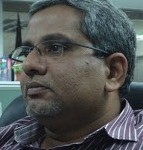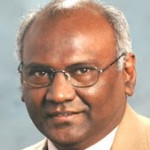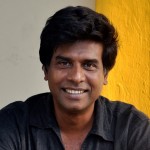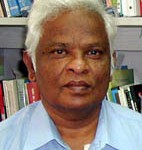–

Gotabaya Rajapaksa
Gotabaya Rajapaksa
I welcome you to this lecture under the National Interest Module of the inaugural MPhil/PhD Programme of the Kotelawala Defence University. The topic of this lecture is “Sri Lanka’s National Security Concerns”. As we all know, Sri Lanka is one of the most peaceful and stable countries in the world today. Our citizens are enjoying the benefits of peace and have complete freedom and countless opportunities to build better futures for themselves. At the same time, it must be understood that as with any other sovereign nation, Sri Lanka faces potential threats from various sources. Guarding against these threats and ensuring the safety of the nation is the first duty of the Government, because National Security is the foundation of our freedom and our prosperity. As such, the Government needs to be fully aware of all the issues that impact the country in areas such as Defence, Foreign Policy, Economic Affairs and internal Law & Order. It must formulate a comprehensive National Security strategy to deal with them.
A viable National Security strategy must constantly align ends with means, goals with resources, and objectives with the tools required to accomplish them. The strategy needs to be aligned with the aspirations of the people, and it must have public support. Ideally, if comprehensive security is to be ensured, it requires the achievement of national cohesion, political and economic stability, the elimination of terrorism, the countering of extremism, and the formulation of effective responses to external challenges. The Government must make every effort to keep aware of a continually changing situation and take appropriate action in response to new developments and challenges. It is only then that the safety of the nation can be assured.
In the course of this lecture on Sri Lanka’s National Security Concerns, I will examine the following areas:
Sri Lanka’s overall National Security context
The primary threats to our National Security at present; and,
The strategies that are being formulated in response to these threats.
The Context of National Security in Sri Lanka
In the first several years after the achievement of Independence, National Security did not need to be a primary concern of the Government of Ceylon. As an independent Dominion of Great Britain, and as a non-aligned nation with excellent relationships within and outside the region, there were few pressing threats that the Government had to deal with. As a result, the attention given to National Security was minimal, as was the emphasis placed on the country’s Defence apparatus. The military was largely ceremonial. It only had to assist the Government on occasions when there were issues such as public sector work stoppages or riots. The need to strengthen law enforcement and the Armed Forces to protect the nation against internal or external threats was not seen as a pressing concern. The attempted coup d’‚tat in 1962 further reduced the attention given to the Defence apparatus by the Government. Due to fears that a strong military would be a threat to democracy, as had been the case in some neighbouring countries during this period, funding for the Armed Forces was drastically reduced and recruitments curtailed.
As a result of the weakening of the military, the country was not in the best position to deal with the first major threat to its National Security when it erupted in 1971. This was the first JVP Insurrection. Although investigations into JVP activities had been going on for some time, cutbacks to intelligence services, including the closure of the Special Branch of the Police in 1970, had left the Government largely unaware of the scale of the insurrection it was facing. The nation’s military was overstretched. In response to the Government’s appeals for help, India and Pakistan sent in troops to secure critical installations while essential equipment and ammunition was provided by Britain and the Soviet Union. Although the insurrection was successfully suppressed within a short time, it had many consequences. One of the most crucial from a historical perspective was that National Security became a much greater concern both for the Government and for the general public. As Ceylon became Sri Lanka in 1972, upholding National Security was one of its foremost priorities.
In the late 1970s, Sri Lanka saw the emergence of the greatest ever threat to its sovereignty in the form of the terrorism of the Tamil separatist groups in the North and East. As the conflict worsened in the early 1980s, particularly after the riots of 1983, the threat of terrorism loomed large not only in the North and East but effectively all over the country. The rise of the Liberation Tigers of Tamil Eelam (LTTE), and the likelihood of its attacks in public places fostered a deep insecurity amongst the people. There was significant loss of life, loss of property, and countless lost opportunities to achieve economic development. The law and order situation deteriorated as arms and ammunition started to flow to criminal elements in the underworld. By the late 1980s, the second JVP insurrection caused the further deterioration of the security situation throughout Sri Lanka. As a result of the increasing instability and violence, people began to lose some of their freedoms as more and more intensive measures had to be taken by the state in trying to uphold public security.
As the terrorism situation worsened, there was also an increasing involvement of foreign powers and the international community in Sri Lanka’s internal affairs. During the early stages of the terrorist conflict, India trained LTTE cadres in training bases established in Tamil Nadu. Many of the leaders of other separatist groups also frequented that state. It is also important to note that several international Non Governmental Organisations that were based in the North and East first started to cooperate with the terrorist groups active in those areas during this period. In 1985, India facilitated talks between the Government of Sri Lanka and the separatist groups in Thimpu, Bhutan. The talks collapsed due to the unrealistic demands made by the separatists. These demands would have gravely affected Sri Lanka’s sovereignty if granted, and the Government had no choice but to refuse them. Fighting soon resumed. By this time, the conflict transformed into one between the state and the LTTE, which had used the ceasefire granted for the Thimpu talks to destroy rival separatist groups.
As the fighting gained momentum, the emphasis given to National Security by the Government also increased. For the first time, the appointment of a Minister of National Security was seen as necessary. The strength of the military was also significantly enhanced, with larger recruitment drives, the acquisition of better assets, and improved training to counter the growing threats. With its improved capabilities, the military was able to make more and more progress in fighting the terrorism of the LTTE. For the first time, we also saw changes within the structure of the military. The need for a coordinated effort to combat terrorism led to the establishment of a Joint Operation Command to coordinate the three Armed Services, Police and Intelligence Services in counter terrorism operations. The military used battle formations for the first time, and the requirement for a National Intelligence Bureau to coordinate the intelligence services at a national level was also understood and subsequently brought into being.
In 1987, the very successful Vadamarachchi Operation enabled the Government to regain control of much of the North, leaving the LTTE on the brink of defeat. At this point, India intervened directly in the conflict by air dropping humanitarian relief supplies over Jaffna. This led to the abandonment of the Vadamarachchi operation, and the Indo-Lanka Accord was signed in July of that year. This led to the induction of the Indian Peacekeeping Force (IPKF) to the North of Sri Lanka, where it got embroiled in conflict with the LTTE. After more than two years of fighting, the IPKF withdrew from Sri Lanka in October 1990, and fighting resumed between the LTTE and Government Forces.
Although there were several periodic attempts at peace talks, the intensity of the war grew during the 1990s and in the early 2000s, with several major battles being fought and much hardship suffered throughout the country. The military was strengthened significantly to deal with this threat. Specialised units such as the Commando Regiment and the Special Forces Regiment of the Army, as well as the Special Boat Squadron of the Navy were developed to deal with the increasing military challenge posed by the LTTE in the North and East. However, in addition to its battles with the military, the LTTE also frequently carried out attacks against civilians in the rest of the country. Large bombings took place in public locations in Colombo, killing thousands. Hundreds more were massacred in vulnerable villages near LTTE dominated territory. Critical installations and economic targets such as the International Airport, Central Bank and the Kolonnawa Oil Refinery were also ruthlessly attacked. In order to contain this very serious threat to national security, precautionary measures had to be greatly increased throughout the country. This led to the visible presence of soldiers on the streets, the widespread use of checkpoints, frequent cordon and search operations, and the constant upholding of the Emergency Regulations, which gave wide-ranging powers to the military and law enforcement agencies. The entire country was effectively on a war footing.
In 2002, the next major development in the conflict was the signing of the Ceasefire Agreement with the LTTE under mediation of Norway. This event can also be viewed as the next major phase in the internationalisation of Sri Lankan affairs as a result of the conflict. The Peace Process that was entered into by the Government of the time was facilitated by Norway, with the support of the representatives of major donor countries, namely the European Union, the United States of America and Japan. Together with Norway, they comprised the four Co-Chairs of the Sri Lankan Peace Process. A Sri Lanka Monitoring Mission was also established, comprising members from Nordic countries, to supervise the implementation of the Ceasefire Agreement. Despite their presence, the LTTE continued to create instability in the country; assassinating its key opponents including Hon. Lakshman Kadirgamar, the Sri Lankan Foreign Minister, and carrying out occasional attacks against civilians.
In 2006, increasing provocations by the LTTE culminated in its threatening of a humanitarian crisis by closing the vital Maavilaru Sluice Gate. This was a crisis that affected the right to water of thousands of households, and even affected national food security by preventing the flow of water to many thousands of acres of agricultural land. The Government intervened with a limited operation to reopen the sluice gate, but was met with large-scale attacks by the LTTE on several fronts. This led to the widening of the military campaign into the Humanitarian Operation that ultimately freed Sri Lanka from terrorism.
The Humanitarian Operation required significant strengthening of the military to enable its success. During the ceasefire period, the LTTE had managed to strengthen its offensive capabilities significantly. It had approximately 30,000 cadres in its ranks and a vast arsenal of weapons and equipment that included heavy artillery, mortar, missiles, rocket propelled grenades, and light aircraft. Combating such an enemy that employed guerrilla tactics required the Sri Lankan Armed Forces to grow significantly. Between the end of 2005 and the end of 2009, the number of Army personnel grew from 120,000 to over 200,000; its 9 Divisions were increased to 20; its 44 Brigades expanded to 71; and its 149 Battalions increased to 284. The Navy and the Air Force were also expanded significantly, and given tasks beyond their classic role. The upholding of security throughout the country also required the Police and Special Task Force to be strengthened, and the Civil Defence Force was revamped and significantly expanded.
Because of the internationalisation of the Sri Lankan situation during the previous decades, there was a great deal of foreign scrutiny on the progress of the Humanitarian Operation. By keeping the Indian leaders constantly informed about what was happening on ground, and by skilfully managing our relationships with other nations, it was possible for the war effort to continue unimpeded. Nevertheless, towards the end of the war in 2009, the Foreign Ministers of France and the United Kingdom arrived in Sri Lanka and attempted to intervene in the military campaign, although they did not succeed. Efforts by such parties to end the Humanitarian Operation reflect the tremendous influence that the LTTE’s international network had on foreign capitals. Many in the international community wilfully ignored the fact that the Government of Sri Lanka was duty-bound to protect its citizens from the aggression of the LTTE terrorists. Even after the war ended and peace dawned in 2009, this bias against the Government led to Sri Lanka being taken up at the United Nations Human Rights Council. Although the initial Resolution against Sri Lanka was defeated that year, two more were sponsored by the United States in 2012 and 2013, and successfully passed.
Today, Sri Lanka is a country enjoying the full benefits of peace, and it is engaged in a concerted push to accelerate its economic development and bring prosperity to its citizens. The country has much to catch up on. Three decades of conflict lost us countless opportunities for growth: foreign and local investment suffered due to fears about the war; tourists did not visit the country, and many of our best and brightest went overseas to build better futures for themselves. Countries such as Singapore, which were in a similar economic position to Sri Lanka when we reached Independence in 1948, developed at a tremendous rate during this period. This is because they did not have a major conflict to contend with. Sri Lanka’s prospects on the other hand were greatly curtailed as a result of the war. This is why the biggest responsibility of the Government of Sri Lanka even today, in the post war situation, is to ensure the continued security of the country. Without security and stability, there will be no economic development. The maintenance of National Security is therefore of the utmost importance.
The National Security of Sri Lanka needs to be addressed in context of the history of this country and the realities of its present situation, and most critically from the perspective of several responsibilities of the state. The state must ensure that the Sovereignty and Territorial Integrity of the nation is maintained, and that there are no threats to the safety of our population. Ensuring economic growth so that the people of the country can uplift their standard of living is also critical in order to prevent internal problems recurring in the future. Creating a favourable environment for Sri Lanka internationally is similarly of the utmost importance in keeping adverse external influence at bay. Securing the safety of our physical assets and safeguarding the nation’s democracy are also critical. Considering this overall context, it is clear that National Security must be understood within a unified, single framework that integrates the nation’s Defence, Law and Order, Foreign Policy and Economic Policy. These four areas need to come together in the creation of a comprehensive National Security Strategy. This is essential if Sri Lanka is to consolidate its present peace and stability and fulfil its potential.
Present National Security Concerns
There are several potential threats in today’s context that Sri Lanka needs to be concerned about. These include:
The possible re-emergence of terrorism
The emergence of other extremist groups
The creation of ethnic divisions and communal violence
The challenges of maritime security and border control
The growth of organised crime
Foreign interference in domestic affairs
Non-traditional threats through technology driven new media, including social media.
In discussing terrorism, it is first of all important to appreciate the sheer scale of the problem that the Government of Sri Lanka was confronted with as a result of the LTTE over the past three decades. Since the 1970s, the LTTE grew from a small organisation of armed individuals to a large, sophisticated terrorist outfit with very advanced combat capabilities. At its height, the LTTE had more than 30,000 battle-hardened cadres; access to large stockpiles of modern armaments, ammunition and equipment; a sophisticated naval wing and a fledgling air wing. For a considerable period of the conflict, the LTTE was able to maintain the illusion of a functional state apparatus in the territories it dominated. It also had significant influence in foreign capitals as a result of its extensive international network. Defeating the LTTE required a concerted effort on the part of the Sri Lankan Government. As a result of the unwavering leadership of His Excellency the President Mahinda Rajapaksa, this task was achieved in May of 2009.
In the immediate aftermath of the war, there were a number of issues that needed to be dealt with. First was the problem of nearly 300,000 internally displaced people who had been used as the LTTE’s human shield during the last phases of the war. Then there was the need to demine the North and East so that those areas would be safe for human habitation. This resulted in the recovery of hundreds of thousands of mines and improvised explosive devices laid by the LTTE during its retreat. Infrastructure development and reconstruction of those areas after years of neglect under the LTTE’s dominance was another significant issue that had to be dealt with, after which it was possible to resettle the IDPs in their places of origin. One of the most important issues was dealing with the nearly twelve thousand surrendered LTTE cadres and four thousand detained cadres. The Government took the bold step of rehabilitating nearly all of them so that they could become productive citizens in future. The vast majority of them have already been reintegrated with society.
Amongst other post war achievements has been the disarming of other armed groups that used to operate in the North and East, and the encouragement these groups have been given to contribute to society through democratic processes. The restrictions that used to be in force on movement, fishing, high security zones etc., have all been removed. Democracy has been completely restored, with free and fair elections taking place. Economic growth in the North and East has been truly remarkable in the recent past, and it is clear beyond doubt that normalcy has been restored to the people.
Despite all of these very positive developments, however, the threat of terrorism re-emerging still persists. One of the main reasons for the LTTE’s success during its heyday was its extensive international network, which has been in operation for many decades. Following the ambush and massacre of 13 soldiers in the North by the LTTE in 1983, there was a major communal backlash against the Tamils in the rest of the country. As a result of the July 1983 riots, a large number of Tamil people left Sri Lanka and travelled to countries such as Canada, the United Kingdom, Malaysia and parts of Europe. These countries granted asylum to these immigrants, and later granted them citizenship. As such, there is a large population of immigrant Sri Lankan Tamils in other countries. A small minority of this population supports the LTTE even to this day. Extremist elements within this community, together with LTTE agents and operatives, including trained terrorists who fled Sri Lanka at various times during the war, comprise the LTTE’s international network.
After the demise of Prabhakaran, the LTTE’s former procurement chief Kumaran Pathmanadan, better known as KP, took control over this network and indicated that it would continue to work for the separatist cause through peaceful means. However, a breakaway faction emerged almost immediately, led by Nediyawan, who wanted to continue Prabhakaran’s ideology of violence. Nediyawan’s group, was previously known as The Tamil Eelam People’s Assembly or the Tamil National Council and is now known as the Tamil Coordinating Committee, Based in Norway, this group has been working with other international groups to promote the LTTE’s separatist cause in many parts of the world. The Tamil Coordinating Committee has control over most of the assets of the LTTE’s international organisation, including its media networks such as Tamil Net.
Following the arrest of KP in August 2009, Rudrakumaran took over the leadership of the main network and began working towards establishing a “Government in Exile”. This group now fashions itself as The Transnational Government of Tamil Eelam. In the guise of fighting for Tamil rights, its primary objective is to lobby foreign Governments for the establishment of a separate state in the North and East of Sri Lanka. The so-called “Transnational Government” has about twenty “Ministers” and “Deputy Ministers”, and was formed with assistance of an advisory committee comprising prominent pro LTTE activists, including foreigners who have been helping the LTTE for many years. There has recently been a revolt within the TGTE, where one third of its members loyal to Nediyawan, went against the leadership of Rudrakumaran because they wished to engage in more radical action.
Another prominent LTTE-linked group emerged out of the British Tamils Association, which was active since 2001 in supporting the terrorism of the LTTE in Sri Lanka. In 2006, the leader of the BTA, Arunachalam Krishanthakumar, alias Shanthan, was investigated on suspicion of supporting terrorist activities. As a result of these suspicions about the BTA, the British Tamils Forum was formed in 2006 to carry on the same activities in a new guise. The BTF acted as an umbrella organisation that mustered support from the immigrant Tamil community and local British politicians for dividing Sri Lanka. With Shanthan’s arrest by British authorities in June 2007 for providing material support to terrorism and his conviction in April 2009, as well as the defeat of the LTTE in May 2009, the role played by the BTF needed to be changed to suit the post-war environment.
As a result of this, the Global Tamils Forum emerged in February 2010, with many of the same members as the BTF. The head of the GTF is the so-called Father Emmanuel, a Priest who was once hailed by Prabhakaran as “a freedom fighter who has given leadership to a movement committed to setting up the homeland to Tamil Eelam”. Father Emmanuel has been engaged in a propaganda campaign against Sri Lanka for many years, targeting Tamil expatriates, Foreign Governments and International Organisations. He is known to have visited LTTE strongholds in Sri Lanka in mid-2000 to conduct training for selected youth who were earmarked to take up overseas appointments for fundraising and propaganda for the LTTE.
Under Father Emmanuel’s guidance, the GTF has successfully influenced a number of politicians from various political parties in European countries as well as the United States, Australia, Canada, and India to support the separatist cause. In addition, the GTF has courted officials within international organisations such as the United Nations, the European Union and various international non-governmental organisations to obtain their support. Part of the success of the GTF in these activities can be attributed to the involvement of influential pro-LTTE foreigners in it. These include Mrs. Joan Ryan, a former British Parliamentarian who has become the Head of the GTF’s Secretariat.
Yet another group that is active internationally in supporting the separatist cause is the LTTE Headquarter Group, which is based in France and headed by Vinayagam, a senior intelligence cadre who managed to escape during the final stages of the war in Sri Lanka. This is a group that is known to engage in Human Smuggling, with some of its past operations including the sending of the “Sun Sea” and “Ocean Lady” vessels from South East Asia to Canada in 2009 and 2010. The members of this group generally maintain a low profile and their movements are kept to a minimum as most of them have been issued Red Notices by Interpol for their involvement in criminal activities. They also keep their distance from both Nediyawan’s and Rudrakumaran’s groups, but maintain links with the GTF.
All of the LTTE-linked groups are coordinated by the GTF and united by one overarching objective. Their unwavering intent is the division of Sri Lanka and the establishment of a separate state for Tamil Eelam. There are several strategies through which they will try to achieve their objective. These include:
The winning of international opinion for the separatist cause,
Increasing international pressure on Sri Lanka in various areas; including pushing for international investigations into war crimes and claims of genocide, and by encouraging international monitoring of the national reconciliation process,
Undermining all efforts of the democratically elected Government of Sri Lanka to create a better future for its citizens through reconciliation and economic development, and
Continuing to push for the resumption of conflict through reorganizing local pro-LTTE elements within Sri Lanka.
Some of the efforts of these LTTE-linked groups have been successful to a certain extent in that despite the war having ended four years ago, the internal affairs of Sri Lanka have been kept at the forefront of the UNHRC’s Sessions as well as at the top of the agenda of several prominent international NGOs even in the recent past. It has to be noted that many of those who create this pressure by claiming to be human rights activists and victims of state repression are actually trained LTTE cadres and operatives who are now fully engaged in propaganda activities. It is very important to understand that their attempts to put pressure on the Government through international bodies such as the UNHRC and non state actors such as international NGOs is designed to strengthen those who work against Sri Lanka’s interests.
In this context it is important to realise that there are groups even within the democratic mainstream in Sri Lanka that obtain funding from the LTTE’s international network and pro-LTTE elements overseas, which more or less openly talk about achieving the very same objectives that the LTTE had. Though they appear to have a democratic face, their actions and remarks clearly show that the extremist separatist ideology has not yet disappeared. Their ultimate objective is achieving the division of Sri Lanka. As a result of their actions and statements, it is very much a possibility that certain radical elements will feel empowered to once again attempt to take up arms in the name of separation. This is a major National Security threat that needs to be taken with the utmost seriousness.
In addition to the threat of terrorism, Sri Lanka also faces a potential threat from other extremist groups. These are the remnants of the radical groups that were involved in previous insurgencies. Some of these groups are trying to reorganise within Sri Lanka and mobilise people to once again take up their extreme left wing causes. There is information that some of these groups have started to link up with the LTTE-linked groups to create further problems in Sri Lanka. Some of their activities include radicalising students and encouraging them to take to the streets in various protests. Though such activities are still in their early stages, they pose another serious National Security concern that we need to be vigilant of.
Another growing concern in the post-war environment is the increasing communalism amongst ethnic groups, which if left unaddressed, could result in the rise of ethnic tensions in the future. During the period of the war, it was not only the Sinhalese and Tamil communities that were affected by the terrorist separatism of the LTTE, but also the Muslims. After the LTTE started engaging in ethnic cleansing in the North in the early 1980s, it expelled the Sinhalese community from Jaffna and soon after turned its attention to the Muslims. Several massacres were carried out at Mosques in the East, and in October 1990, the LTTE expelled more than 75,000 Muslim residents from the North. This was followed by further brutal attacks on Muslims in vulnerable villages near the territory dominated by the LTTE. In this environment, the Muslims also started to organise themselves for their own protection against the LTTE. After the LTTE’s defeat, some of these groups have begun to engage in activities that stem far beyond self-protection. There is some information that some of these groups have even tried to link up with the global Islamic terrorist movement. This is a situation that requires careful monitoring.
On a broader scale, it also has to be acknowledged that one of the consequences of the terrorist conflict Sri Lanka endured for thirty years has been the increased insularity of ethnic groups. Rather than identifying themselves on the basis of nationality, the communities of Sri Lanka have begun to identify themselves on the basis of their ethnicity or their religion. Instead of calling themselves Sri Lankan, they identify themselves as Sinhalese or Tamils or Muslims or Buddhists or Christians. This fragmentation of the Sri Lankan identity is most unfortunate, because activists within these communal groups seek minority rights or ethnic rights rather than working within the framework of a common national identity.
The cross-border links that can arise as a result of such insular ethnic or religious identification is also very troublesome. It is clear that there are some in the Tamil community who identify themselves more with the Tamil community of Tamil Nadu than with their fellow Sri Lankans. This has been encouraged by some parties overseas who wish to promote the idea of a greater Tamil Nation. Similarly, it has been observed that there are some foreign groups that wish to encourage Sri Lankan Muslims to identify themselves more with the global Muslim community, thereby reducing their integration within Sri Lanka. This trend has been particularly prevalent in the post September 11 world, in which there has been a tendency among certain groups to try and influence the global Muslim community towards religious extremism has become visible.
The increasing insularity and cohesion amongst minority ethnic groups has also led to the emergence of hard line groups from the majority community: the popularity of certain political groups and movements can be viewed as being largely a response to this trend. In turn, the emergence of hard line groups in the majority community causes further tensions amongst other communities, which leads to a vicious cycle of greater fragmentation of the Sri Lankan identity. Sri Lanka had enough divisions in the past that ultimately led to conflict; we must learn the lessons from our past and ensure that history is not repeated. This is therefore a very serious National Security concern at the present moment.
The maintenance of maritime security is another serious National Security Concern that the Government needs to be vigilant about. As an island, Sri Lanka does not have land borders to worry about, but maintaining maritime security is a serious challenge. In the past, the only maritime security issues that had to be dealt with was the illegal movement of Indians into Sri Lanka and the smuggling that took place between Sri Lanka and South India. Preventing these threats was one of the foremost duties of the military in the 1950s and the 1960s. However, with the development of the LTTE and other terrorist groups in the 1970s and beyond, maritime security became a major concern to Sri Lanka.
For example, it is a well-known fact that the LTTE acquired a vast arsenal of weapons and equipment including artillery, missiles, mortars, armoured vehicles and even light aircraft. None of these items were produced in Sri Lanka, but were brought into Sri Lanka through the sea. In addition to military supplies, the LTTE’s cadres were initially trained at bases in Tamil Nadu. Given the recent activities of LTTE-linked organisations outside Sri Lanka and particularly in Tamil Nadu, this is very much a current threat even today.
The organised trafficking of persons or human smuggling is another significant maritime security issue. Organised groups, some of which are connected to LTTE-linked organisations, have lured many people seeking better economic prospects into this lucrative illegal operation. During this year alone, more than 440 such people have attempted to leave Sri Lanka illegally. Having sold their properties and handed over all their wealth to the operators of these schemes, the victims of human trafficking find themselves trapped on board unsafe vessels along with hundreds of others, travelling to countries that will most often refuse them entry. In order to make a compelling case for their acceptance by border control authorities abroad, such economic refugees often concoct stories about being persecuted in Sri Lanka, thereby damaging the country’s reputation. Furthermore, the mechanisms of human trafficking have enabled trained terrorists to escape justice in Sri Lanka and flee abroad to safe havens, from which they may once again attempt to cause problems to the country through other means.
A further consideration with regard to maritime security is the protection of our maritime assets. One of the problems Sri Lanka has faced in the maritime domain after the defeat of the LTTE has been the increasing incidence of pirate fishing in Sri Lankan waters by South Indian fishermen. These fishermen use illegal practices such as bottom trawling to maximise their catch. This causes serious damage to the healthy fish stocks in Sri Lankan waters, and also adversely affects the livelihoods of our own fishermen. These fishing boats that enter Sri Lankan waters illegally have also been known to engage in other criminal activities including drug smuggling. Protecting our waters from these fishermen, as well as from others who might seek to exploit our other oceanic resources including oil and gas, will be one of the key maritime security challenges for Sri Lanka in the future.
Somewhat farther afield, the threat of international piracy is also a concern for Sri Lanka’s maritime security. Many of the world’s most important Sea Lanes of Communications are located in close proximity to Sri Lanka, and both the newly built Hambantota Port as well as the Colombo port are ideally situated to service the hundreds of vessels that cross these lanes on a daily basis. The reach and sophistication of the pirates originating mostly from East Africa has been increasing in recent years. This factor undermines the security of these Sea Lanes and could pose a serious problem to shipping in the region in the future. This will have an impact on the country’s economic security as well, and is therefore another challenge that needs to be monitored.
With regard to border security, one of the concerns Sri Lanka has is the possibility of the country being used as a transit point for transnational crime. The arrest of certain elements connected with extremist regional terrorist groups in India and Pakistan have shown that they have used Sri Lanka as a transit point from which to coordinate their activities. Some who are known to have been temporarily sheltered in Sri Lanka by an International Organisation after claiming refugee status in the west, are known criminals who engaged in illegal activities such as credit card fraud, drug smuggling and counterfeit currency printing abroad.
Organised crime in Sri Lanka is another issue that needs to be addressed. As a result of the rise of terrorism and the insurrections Sri Lanka experienced over the last forty years, and the response required from the state, a considerable amount of arms and ammunition inadvertently fell into the hands of criminals. This led to the rise of the underworld, which is now engaged in a number of organised criminal activities including drugs, armed robberies, kidnappings for ransom and financial frauds. There are also groups that engage in seizing land illegally. Tackling the challenges posed by organised criminal groups is another priority for the state.
In today’s environment, the possibility of foreign interference in our internal affairs remains a significant National Security concern. With the involvement of countries like India, Norway, and the United States of America in Sri Lanka as a result of the terrorist conflict, matters relating to this country’s internal affairs have gained increased visibility within the international community. India in particular is very sensitive to what is going on in Sri Lanka because of the large Tamil population in its influential southern state of Tamil Nadu. Especially during the elections cycle, Sri Lanka figures large in its power politics. In the recent past, we have seen even the Chief Minister of Tamil Nadu attempting to pressurise the central government into opposing Sri Lanka internationally. This is a serious threat to Sri Lanka’s security, and perhaps even its sovereignty.
Furthermore, as a result of the rapid economic and military development of countries like India and China in recent decades, the entire Asian region has become increasingly important in global affairs. Because of Sri Lanka’s important geostrategic position within the Indian Ocean region, a great deal of attention is therefore placed upon it in the present era. There is a possibility that some western powers wish to have a Sri Lankan Government that is closely aligned with their interests, and will seek to influence Sri Lanka’s destiny so that it cannot pursue the independent course it is following at present.
A third factor that has led to Sri Lanka’s increasing importance in the international arena involves regional power politics. The issues between India and Pakistan, and the issues between India and China are particularly sensitive in this regard. With the rise of China as a world economic leader, there is a widespread belief that India feels insecure and is seeking to align itself with the other powers that seem similarly threatened by China’s ascendancy. The likelihood of the United States showing more interest in the region and aligning more with India is a factor that may affect Sri Lanka. Further, its establishment of a base in the Maldives is also changing the complexion of the region. These are developments that need to be monitored from the point of view of Sri Lanka’s national security.
The final threat to Sri Lanka’s National Security that I will highlight during this lecture is the emergence of technology driven new media including social media sites such as Facebook, Twitter and other websites on the Internet. We have seen the potential of this new media to destabilise nations and affect serious change in the case of countries like Tunisia, Libya, Egypt etc. Although the likelihood of events such as the Arab spring transpiring in Sri Lanka is minimal as a result of it being a democratic nation with an extremely popular political leadership that enjoys a very large electoral majority, this is yet another threat that needs to be monitored. Particularly due to increasing Internet penetration and computer literacy in Sri Lanka, many of our youth are familiar with social media and use it as a tool to gather information as well as propagate ideas. Those with vested interests can exploit social media to cause problems in Sri Lanka by propagating certain ideologies online and mobilising and organising people. This can be done with a minimal physical presence, and therefore forms a threat that is difficult to contain through the traditional tools of national defence.
National Security Response
Considering the foregoing threat assessment, it is clear that despite Sri Lanka being in a post-war situation in which most people are only concerned about economic development, National Security remains very much a core concern for the Government. In addressing the challenges discussed above and developing a comprehensive National Security Strategy, it is important for the Government to take a holistic view and incorporate many of its elements into a single policy framework.
In terms of internal security, the best response to most of the threats that we face is the development of the Intelligence Services. Sri Lanka has two primary intelligence arms: the State Intelligence Service and the Defence Intelligence, which comprises the Directorate of Military Intelligence, Directorate of Naval Intelligence, and Air Intelligence. In addition, the Police maintains the Special Branch, while the Special Task Force also has its own Intelligence Division. Furthermore, the Terrorist Investigation Department and Criminal Investigation Department of the Police also work closely with the other Intelligence agencies on matters relating to National Security.
In the past, the lack of strength and coordination amongst these various intelligence services used to be a serious issue. It is essential that they work together under a unified command structure in order to improve coordination and enhance capabilities. Towards this effect, one of the efforts undertaken by the present Government has been to bring these intelligence services under the Chief of National Intelligence, who reports directly to the Secretary to the Ministry of Defence. This has streamlined coordination and improved cooperation amongst the intelligence agencies.
Another important development in this regard has been the augmenting of resources allocated for the Intelligence function. After the war, the number of military intelligence units have been increased and each Security Force Head quarters now has its own Intelligence Unit. The Intelligence personnel are being afforded more and more training in order to enhance their capabilities and capacities, and as Sri Lanka moves forward, it is hoped that the Intelligence agencies will be able to keep track of and contain domestic National Security concerns.
Furthermore, although the requirement for offensive military operations no longer exists in Sri Lanka, it is of the utmost importance that our security measures are not relaxed. Although the military is not engaged in law enforcement activities, and although their visible presence has been greatly reduced, it is essential for the military to be placed in strategic locations throughout Sri Lanka. Particularly in the North and East, where we know that there are still potential threats to National Security, it is essential to have a significant though unobtrusive military presence. Some recent efforts of international elements to reorganise pro-LTTE elements in the North underscores the need for this. For example, the recent arrest of some youth in Jaffna and Chennai who had been recruited by a Chennai based LTTE-linked group funded by the LTTE’s Europe based network, shows the utmost need to remain vigilant in this regard.
It must also be underscored that as a Sovereign nation, Sri Lanka has every right to place its security elements in any part of the country it so chooses. While some in the international community talk about the so-called militarisation of the North and East, and some political parties in Sri Lanka decry the presence of the military in these areas, it must also be understood that the people of the North and East mostly have a very cordial relationship with the military. Since the end of the war, the military has been involved in a great deal of reconstruction work, and they have also supported the people of the area to resume their livelihoods. They have provided equipment and material for agriculture, fishing and various types of assistance for small business development. The increased attention given to Civic-Military affairs also helps National Security because it helps the Armed Forces to win the hearts and minds of the people in the former conflict areas.
With regard to the work of the Defence services in the post-war environment, it is also essential to expand the responsibilities of the Navy and the Coast Guard. The protection of Sri Lanka’s maritime borders is of the utmost importance, and there is a great deal of responsibility on these two institutions to safeguard our seas. The Exclusive Economic Zone Sri Lanka enjoys needs to be protected, as it is a vital economic asset. The Navy needs to get more naval assets so that it has the ability to patrol or dominate the blue seas. It is also important to improve the Navy’s surveillance capabilities through augmenting its Radars and adding a new air surveillance capability. The Air Force, too, needs to improve it capabilities with regard to surveillance operations.
Another aspect of internal security that needs to be mentioned is the rectification of weaknesses that we used to have with regard to the national identity system. Because it was a manual, paper-based system, criminal and terrorist elements could very easily obtain forged identity cards. This enabled the terrorists to operate throughout Sri Lanka under various names and aliases; this is why the threat of suicide bombings and other attacks in the rest of Sri Lanka was such a pressing problem during the period of the war. To address this critical weakness, the Registrar of Persons Department was brought under the Ministry of Defence & Urban Development, and a new identity card system that uses biometric information will be introduced shortly. Similarly, the problem of people coming into Sri Lanka and staying here illegally under false pretences will be addressed through the introduction of a proper border control system in which biometric information will be incorporated into the passport and international standards used for identity verification.
From the point of view of domestic security, perhaps the most critical aspect will be the achievement of national reconciliation and the forging of a common Sri Lankan identity. Economic development is an absolute necessity in this regard. The fact remains that unless people enjoy a reasonable standard of living, peace and reconciliation are very difficult to achieve. This is why the Government has spared no expense or effort to develop infrastructure and build up the North and East to a high standard. This will enable the benefits of peace to flow down to the people of those areas. When people know that they have the opportunity to achieve a better future for themselves, it is highly unlikely that they will waste their time on violent ideologies. The achievement of economic development and national reconciliation are therefore two of the key areas of focus of the Government in the present national context.
Finally, with regard to external threats, it is of the utmost importance that Sri Lanka maintains cordial relationships with its allies. Despite the present pressure from Tamil Nadu, it is essential to maintain a strong and healthy relationship with India. Relations with the many countries that helped us in the past, both in economic terms and through political support, should be strengthened further through skilful diplomacy and further development of mutual ties. It essential to further strengthen the existing cordial relationships with powerful nations such as China and Russia, which have permanent seats on the United Nations Security Council and can influence any international action on Sri Lanka more significantly than other nations. In this overall context, it is very important that the foreign policy of Sri Lanka needs to be realistic. It is essential for Sri Lanka to have close ties with certain powerful nations in the international community in order to safeguard its National Security interests.
During the course of this lecture I have outlined the overall context of Sri Lanka’s National Security concerns; identified our most pressing threats and discussed the broad outlines of the Government’s strategy to deal with all these issues. Ultimately, the best way to ensure that Sri Lanka remains safe and strong in the future is for all of us to put aside the differences of the past; unite as Sri Lankans, and work towards a better future for ourselves and for each other.
Thank you.




















